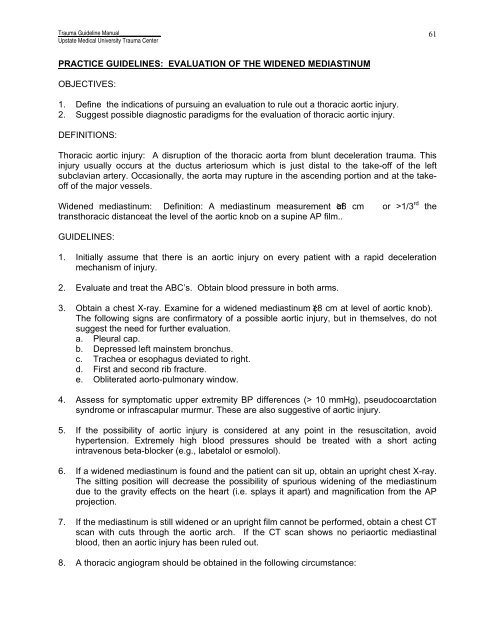Trauma Guideline Manual - SUNY Upstate Medical University
Trauma Guideline Manual - SUNY Upstate Medical University
Trauma Guideline Manual - SUNY Upstate Medical University
You also want an ePaper? Increase the reach of your titles
YUMPU automatically turns print PDFs into web optimized ePapers that Google loves.
<strong>Trauma</strong> <strong>Guideline</strong> <strong>Manual</strong>______________<strong>Upstate</strong> <strong>Medical</strong> <strong>University</strong> <strong>Trauma</strong> Center61PRACTICE GUIDELINES: EVALUATION OF THE WIDENED MEDIASTINUMOBJECTIVES:1. Define the indications of pursuing an evaluation to rule out a thoracic aortic injury.2. Suggest possible diagnostic paradigms for the evaluation of thoracic aortic injury.DEFINITIONS:Thoracic aortic injury: A disruption of the thoracic aorta from blunt deceleration trauma. Thisinjury usually occurs at the ductus arteriosum which is just distal to the take-off of the leftsubclavian artery. Occasionally, the aorta may rupture in the ascending portion and at the takeoffof the major vessels.Widened mediastinum: Definition: A mediastinum measurement of ≥8 cm or >1/3 rd thetransthoracic distanceat the level of the aortic knob on a supine AP film..GUIDELINES:1. Initially assume that there is an aortic injury on every patient with a rapid decelerationmechanism of injury.2. Evaluate and treat the ABC’s. Obtain blood pressure in both arms.3. Obtain a chest X-ray. Examine for a widened mediastinum (≥8 cm at level of aortic knob).The following signs are confirmatory of a possible aortic injury, but in themselves, do notsuggest the need for further evaluation.a. Pleural cap.b. Depressed left mainstem bronchus.c. Trachea or esophagus deviated to right.d. First and second rib fracture.e. Obliterated aorto-pulmonary window.4. Assess for symptomatic upper extremity BP differences (> 10 mmHg), pseudocoarctationsyndrome or infrascapular murmur. These are also suggestive of aortic injury.5. If the possibility of aortic injury is considered at any point in the resuscitation, avoidhypertension. Extremely high blood pressures should be treated with a short actingintravenous beta-blocker (e.g., labetalol or esmolol).6. If a widened mediastinum is found and the patient can sit up, obtain an upright chest X-ray.The sitting position will decrease the possibility of spurious widening of the mediastinumdue to the gravity effects on the heart (i.e. splays it apart) and magnification from the APprojection.7. If the mediastinum is still widened or an upright film cannot be performed, obtain a chest CTscan with cuts through the aortic arch. If the CT scan shows no periaortic mediastinalblood, then an aortic injury has been ruled out.8. A thoracic angiogram should be obtained in the following circumstance:
















